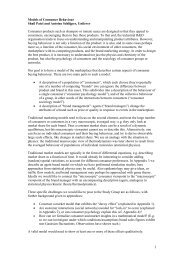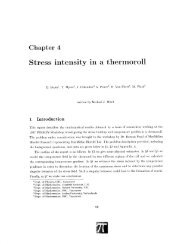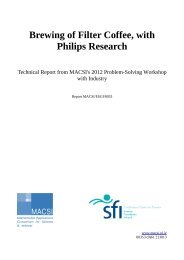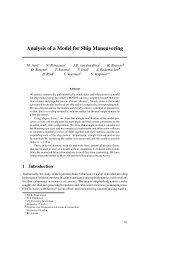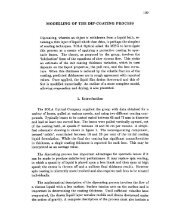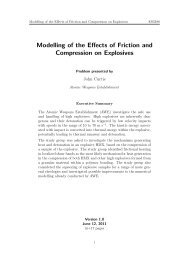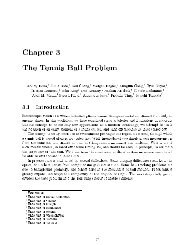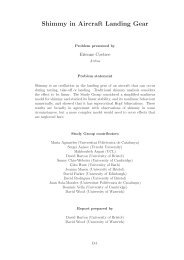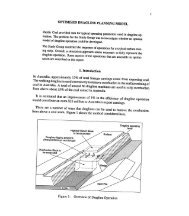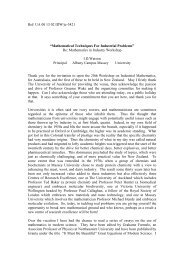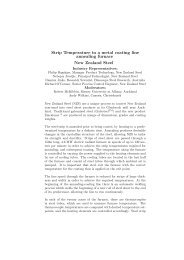Mathematical Models for Estimating the Risk of vCJD Transmission
Mathematical Models for Estimating the Risk of vCJD Transmission
Mathematical Models for Estimating the Risk of vCJD Transmission
Create successful ePaper yourself
Turn your PDF publications into a flip-book with our unique Google optimized e-Paper software.
Proceedings <strong>of</strong> <strong>the</strong> OCCAM–Fields–MITACS Biomedical Problem Solving Workshop, 2009<br />
<strong>Ma<strong>the</strong>matical</strong> <strong>Models</strong> <strong>for</strong> <strong>Estimating</strong> <strong>the</strong> <strong>Risk</strong> <strong>of</strong> <strong>vCJD</strong><br />
<strong>Transmission</strong><br />
Problem Presenters: Mustafa Al-Zoughool (University <strong>of</strong> Ottawa) and Susie El Saadany<br />
(Public Health Agency <strong>of</strong> Canada)<br />
Contributors: Vahid Anvari (York University), Mahshid Atapour (York University), Lydia<br />
Bourouiba (York University), Luz Angélica Caudillo Mata (CIMAT—Center <strong>for</strong> <strong>the</strong><br />
<strong>Ma<strong>the</strong>matical</strong> Research), Shannon Collinson (York University), Venkate Duvvuri (York<br />
University), Hongbin Guo (York University), Angella Johnson (University <strong>of</strong> Sou<strong>the</strong>rn Cali<strong>for</strong>nia),<br />
Neal Madras (York University), Peter Miasnik<strong>of</strong> (University <strong>of</strong> Toronto), Lilia L.<br />
Ramírez Ramírez (University <strong>of</strong> Waterloo), and Ivete Sánchez-Bravo (CIMAT—Center <strong>for</strong><br />
<strong>the</strong> <strong>Ma<strong>the</strong>matical</strong> Research).<br />
Report prepared by 1 : V. Anvari, M. Atapour, L. Bourouiba, L. A. Caudillo Mata, S.<br />
Collinson, A. Johnson, N. Madras, P. Miasnik<strong>of</strong>, L. L. Ramírez Ramírez, I. Sánchez-Bravo.<br />
1 Introduction<br />
Transmissible spongi<strong>for</strong>m encephalopathies (TSE’s), also known as prion (proteinaceous<br />
infectious particles) diseases, are a group <strong>of</strong> fatal brain diseases that affect both animals<br />
and humans. They are characterized by long incubation periods, spongi<strong>for</strong>m changes, and<br />
astrogliosis.<br />
Infective prions propagate by refolding into abnormal structures which cause <strong>the</strong> conversion<br />
<strong>of</strong> normal protein molecules into <strong>the</strong> abnormally structured <strong>for</strong>ms. These prions (TSE<br />
agents) are resistant to inactivation by conventional decontamination methods. They also<br />
resist all routine sterilization procedures commonly used in health care facilities. Because <strong>of</strong><br />
<strong>the</strong> unconventional transmissions <strong>of</strong> <strong>the</strong>se agents, <strong>the</strong>y are <strong>of</strong> particular concern <strong>for</strong> public<br />
health.<br />
Variant Creutzfeldt Jakob Disease (<strong>vCJD</strong>) is a human <strong>for</strong>m <strong>of</strong> Bovine (Transmissible)<br />
Spongi<strong>for</strong>m Encephalopathy or mad cow disease. Variant CJD is an infectious disease<br />
1 anvari@mathstat.yorku.ca, atapour@mathstat.yorku.ca, lydia.bourouiba@math.mit.edu,<br />
langel@cimat.mx, mscolli@yorku.ca, angelajo@usc.edu, madras@mathstat.yorku.ca,<br />
p.miasnik<strong>of</strong>@utoronto.ca, llramire@uwaterloo.ca, ivete@cimat.mx<br />
81<br />
c○2009
82 <strong>Ma<strong>the</strong>matical</strong> <strong>Models</strong> <strong>for</strong> <strong>Estimating</strong> <strong>the</strong> <strong>Risk</strong> <strong>of</strong> <strong>vCJD</strong> <strong>Transmission</strong><br />
typified by long incubation periods and asymptomatic infections—two factors making epidemiological<br />
investigations particularly difficult. Two modes <strong>of</strong> infection <strong>of</strong> <strong>vCJD</strong> have been<br />
identified:<br />
• Primary infections: associated with <strong>the</strong> ingestion <strong>of</strong> infectious materials (mainly<br />
BSE-contaminated beef),<br />
• Secondary infections: associated with receiving blood from an infected blood pool<br />
(particularly through transfusions) and with <strong>the</strong> use <strong>of</strong> infected surgical instruments.<br />
The number <strong>of</strong> cases <strong>of</strong> <strong>vCJD</strong> is relatively small, but its characteristic incubation period<br />
coupled with unconventional transmissibility has presented a challenge <strong>for</strong> parameter<br />
estimation and modeling dynamics. In spite <strong>of</strong> <strong>the</strong> fact that only one <strong>vCJD</strong> case has been<br />
detected in Canada (in 2002) it is important to study possible transmission scenarios. Indeed,<br />
outbreaks can potentially develop into epidemics, as <strong>the</strong> outbreak in UK (in <strong>the</strong><br />
1990’s) has shown.<br />
Since <strong>the</strong> epidemic course shows geographical differences, every country should assess<br />
its specific <strong>vCJD</strong> risk as a condition <strong>for</strong> developing a national blood supply strategy. A<br />
group was <strong>for</strong>med <strong>for</strong> this purpose in Germany in 2001, and its findings are available in<br />
[16].<br />
To prevent secondary transmission through blood components, several countries have<br />
started to exclude recipients <strong>of</strong> blood transfusions from being donors. A recent study [7]<br />
investigated <strong>the</strong> effectiveness <strong>of</strong> this measure using a dynamic age-structured model based<br />
on German epidemiological data. An important question <strong>for</strong> us is whe<strong>the</strong>r Canada should<br />
ban recipients <strong>of</strong> blood transfusions from donating blood. On <strong>the</strong> one hand, this ban could<br />
prevent some new cases <strong>of</strong> <strong>the</strong> terrible disease <strong>vCJD</strong>; on <strong>the</strong> o<strong>the</strong>r hand, it would significantly<br />
decrease <strong>the</strong> number <strong>of</strong> blood units collected by Canadian Blood Services. To help us choose<br />
between <strong>the</strong>se alternatives, we would like to predict <strong>the</strong> number <strong>of</strong> new <strong>vCJD</strong> cases that<br />
would be prevented if Canada were to enact this ban.<br />
In this report, we use two models to describe <strong>the</strong> plausible evolutions <strong>of</strong> <strong>vCJD</strong> outbreaks<br />
in Canada. In <strong>the</strong> next two sections, <strong>the</strong>se models and <strong>the</strong>ir underlying assumptions are<br />
thoroughly discussed. In Section 2 we use a classical compartmental model to describe<br />
<strong>the</strong> evolution <strong>of</strong> <strong>the</strong> infected population originated from primary infections and secondary<br />
infections. We examine possible parameter values and scenarios based on data. The roles<br />
<strong>of</strong> <strong>the</strong> two key transmission parameters are examined. Section 3 explores a stochastic<br />
model that could help predict <strong>the</strong> consequences <strong>of</strong> a <strong>vCJD</strong>-infected individual entering <strong>the</strong><br />
Canadian blood-donor pool. Both simulation and analytical results are presented. Some<br />
brief concluding remarks appear in Section 4.<br />
2 A Deterministic Model<br />
The first basic deterministic time-continuous compartmental models to describe <strong>the</strong><br />
transmission <strong>of</strong> communicable disease are contained in a sequence <strong>of</strong> three papers by Kermack<br />
and McKendrick in 1927, 1932 and 1933 [10]. These models have been generalized<br />
and a recommended introduction to <strong>the</strong> topic is provided in <strong>the</strong> first two chapters in [2].<br />
The deterministic compartmental model can be directly translated into a Markovian<br />
stochastic version by re<strong>for</strong>mulating <strong>the</strong> ordinary differential equations that describe <strong>the</strong><br />
deterministic dynamics, as <strong>the</strong> transition probabilities (+o(dt)) <strong>of</strong> <strong>the</strong> process. In this<br />
underlying stochastic model <strong>the</strong> process has latent (if considering an SEIR model) and<br />
infectious periods that are exponentially distributed.
<strong>Ma<strong>the</strong>matical</strong> <strong>Models</strong> <strong>for</strong> <strong>Estimating</strong> <strong>the</strong> <strong>Risk</strong> <strong>of</strong> <strong>vCJD</strong> <strong>Transmission</strong> 83<br />
In this section we only explore <strong>the</strong> deterministic version <strong>of</strong> <strong>the</strong> <strong>vCJD</strong> infectious dynamics<br />
considering primary and secondary infections (via blood transfusion) and <strong>the</strong> sensitivity <strong>of</strong><br />
outbreak to <strong>the</strong> change <strong>of</strong> some parameter values.<br />
The analysis in this section aims to study <strong>the</strong> general characteristics and rough uncontrolled<br />
outbreak scenarios derived from infections by food intake and blood transfusion. The<br />
number <strong>of</strong> infected individuals is obtained in <strong>the</strong> long term with <strong>the</strong> purpose <strong>of</strong> exploring<br />
<strong>the</strong> evolutionary epidemic trends ra<strong>the</strong>r than <strong>for</strong>ecasting outbreak outcomes.<br />
2.1 Model. The population is subdivided into susceptible S(t), primary infected (by<br />
beef consumption) I 1 (t), secondary infected (by blood transfusion) I 2 (t), and removed R(t)<br />
individuals.<br />
Compartmental models assume that individuals in <strong>the</strong> entire population mix homogenously,<br />
so <strong>the</strong> rate <strong>of</strong> interaction between two different subsets <strong>of</strong> <strong>the</strong> population is proportional<br />
to <strong>the</strong> product <strong>of</strong> <strong>the</strong> number in each subset.<br />
Regarding <strong>the</strong> <strong>vCJD</strong> transmissibility in <strong>the</strong> infectious process, if we have an almost<br />
completely susceptible population we suppose that each infected beef cow infects β 1 individuals<br />
and that each infected individual annually transmits <strong>vCJD</strong> to β 2 individuals by<br />
blood transfusion.<br />
We also assume that every individual becomes infectious immediately after being infected<br />
by ei<strong>the</strong>r ingesting contaminated beef or receiving infected blood. This, added to<br />
<strong>the</strong> fact that individuals die just a few weeks or months after presenting <strong>vCJD</strong> symptoms,<br />
makes <strong>the</strong> infectious periods very similar to <strong>the</strong> illness’s latent periods. Here we consider<br />
<strong>the</strong> two kinds <strong>of</strong> periods as equal.<br />
We include two different incubation periods <strong>for</strong> primary and secondary cases. In both<br />
cases <strong>the</strong> periods are exponentially distributed but with means 1/γ 1 and 1/γ 2 , respectively.<br />
Due to <strong>the</strong> fact that <strong>the</strong> evolution <strong>of</strong> <strong>vCJD</strong> is long, it is important to introduce <strong>the</strong><br />
demographical changes that occur in a population. The two demographical variables that<br />
we consider in this section are <strong>the</strong> births and deaths. We respectively denote as π and δ<br />
<strong>the</strong> crude annual birth and death rates in Canada.<br />
Let N(t) be <strong>the</strong> total population at time t. Since <strong>vCJD</strong> is a fatal disease, <strong>the</strong>n N(t) =<br />
S(t) + I 1 (t) + I 2 (t). There<strong>for</strong>e <strong>the</strong> interactions <strong>of</strong> our compartmental model are depicted by<br />
Figure 1 and it is <strong>for</strong>malized by <strong>the</strong> following differential equations:<br />
dS<br />
dt<br />
dI 1<br />
dt<br />
dI 2<br />
dt<br />
dR<br />
dt<br />
= πN − β 1<br />
N SC − β 2<br />
N S(I 1 + I 2 ) − δS, (2.1)<br />
= β 1<br />
N SC − γ 1I 1 − δI 1 , (2.2)<br />
= β 2<br />
N S(I 1 + I 2 ) − γ 2 I 2 − δI 2 , (2.3)<br />
= γ 1 I 1 + γ 2 I 2 , (2.4)<br />
where C is <strong>the</strong> number <strong>of</strong> BSE infected beef cases in Canada in a year. The term β 1 SC/N in<br />
(2.1) and (2.2) describes <strong>the</strong> number <strong>of</strong> susceptible individuals who acquire <strong>vCJD</strong> by eating<br />
BSE infected meat. When S ∼ N <strong>the</strong>n this number is equal to β 1 C as described above.<br />
The expression β 2 S(I 1 + I 2 )/N in (2.1) and (2.3) describes <strong>the</strong> number <strong>of</strong> new infections<br />
by blood transfusion from infected individuals (ei<strong>the</strong>r primary or secondary cases). Then if<br />
S ∼ N each infective originates β 2 new cases.
84 <strong>Ma<strong>the</strong>matical</strong> <strong>Models</strong> <strong>for</strong> <strong>Estimating</strong> <strong>the</strong> <strong>Risk</strong> <strong>of</strong> <strong>vCJD</strong> <strong>Transmission</strong><br />
Figure 1 Interactions <strong>of</strong> <strong>the</strong> deterministic compartmental model.<br />
2.2 Parameters. Now we discuss <strong>the</strong> parameter values used to describe <strong>the</strong> infectious<br />
dynamics. Some infectious scenarios are explored in Section 2.4 by varying some <strong>of</strong> <strong>the</strong><br />
parametric values.<br />
Since 1993, one percent <strong>of</strong> <strong>the</strong> cattle have been tested in Canada and only 18 have been<br />
found to be infected with BSE [4]. On <strong>the</strong> o<strong>the</strong>r hand, according to Canada Livestock and<br />
Products Annual 2007 [17], approximately 3,825,000 heads are slaughtered in Canada every<br />
year. If we assume that <strong>the</strong> 18 infected animals were uni<strong>for</strong>mly found during <strong>the</strong>se 16 years<br />
and that beef consumption over this period has been approximately equal to <strong>the</strong> 2007 levels,<br />
<strong>the</strong>n <strong>the</strong> number <strong>of</strong> BSE cases during a year is close to Ĉ = 3, 825, 000 × α = 112.5, where<br />
α is <strong>the</strong> estimated fraction <strong>of</strong> infected heads (α = 2.94 × 10 −5 ).<br />
As stated in [15], <strong>the</strong> annual Canadian beef consumption in recent years has been<br />
approximately 23.3 kg per person. We know that a single animal provides between 140 and<br />
200 kg <strong>of</strong> edible meat. Consequently, we calculate that a single BSE infected bovine can<br />
contaminate between 700 (140 kg/200 grams per meal portion) and 6,667 (200 kg/30 grams<br />
per meal portion) individuals. If we assume that each bovine provides 170 kg <strong>of</strong> edible meat<br />
and <strong>the</strong> individual portions are 65 grams (64.7 grams per day = 23.3 kg /360 days), <strong>the</strong><br />
number <strong>of</strong> individuals infected by one diseased bovine would be 2,615.<br />
Because <strong>the</strong> most dangerous parts <strong>of</strong> <strong>the</strong> animal are now eliminated from human consumption<br />
(those that contain sections <strong>of</strong> <strong>the</strong> central nervous system), <strong>the</strong> probability that<br />
an individual acquires <strong>vCJD</strong> by consuming meat from an infected animal decreases by half.<br />
Hence ˆβ 1 = 1, 307. In <strong>the</strong> next section we will explore some o<strong>the</strong>r values <strong>for</strong> this parameter.<br />
In order to estimate β 2 , we use a case study from Britain where 4 out <strong>of</strong> a total <strong>of</strong> 66<br />
individuals who had received blood from a blood pool contaminated by a single infected
<strong>Ma<strong>the</strong>matical</strong> <strong>Models</strong> <strong>for</strong> <strong>Estimating</strong> <strong>the</strong> <strong>Risk</strong> <strong>of</strong> <strong>vCJD</strong> <strong>Transmission</strong> 85<br />
(a)<br />
(b)<br />
Figure 2 Epidemic curves, (a) evolution <strong>of</strong> outbreak in Canada, (b) as in (a) except<br />
individuals are separated into primary and secondary infections.<br />
donor contracted <strong>vCJD</strong> after <strong>the</strong>ir transfusion. Even though <strong>the</strong> donor pool size can vary,<br />
<strong>the</strong> number <strong>of</strong> affected individuals may remain similar due to factors such as dilution <strong>of</strong><br />
<strong>the</strong> particles that transmit <strong>the</strong> disease (see [6]). We consider that <strong>the</strong> number <strong>of</strong> infected<br />
individuals originated from a single infected person who donates blood is constant and equal<br />
to 4.<br />
Now, we also have that <strong>the</strong> fraction <strong>of</strong> people that donated blood in Canada in 2007<br />
was 1/60, [3], and from those individuals 335,000 donated once, 90,000 donated twice,<br />
110,500 donated between 3 and 5 times, and 14,500 donated 6 or 7 times during <strong>the</strong> year.<br />
Thus <strong>the</strong> expected number <strong>of</strong> times that <strong>the</strong> same individual gives blood in a year, is<br />
approximately 1.91. Hence <strong>the</strong> estimated new cases an infected individual originates in one<br />
year is ˆβ 2 = 2/60 × 4 = 0.1333.<br />
The estimated incubation periods in individuals that acquired <strong>vCJD</strong> by eating contaminated<br />
beef and blood transfusion has been estimated to be between 13 and 40 years and<br />
between 5 and 6 years, respectively. Using <strong>the</strong> midpoints <strong>of</strong> <strong>the</strong>se intervals we have<br />
ˆγ 1 = 1<br />
26.5 = 0.03773 and ˆγ 2 = 1<br />
5.5 = 0.181818.<br />
From <strong>the</strong> demographical in<strong>for</strong>mation in [14] we obtain <strong>the</strong> crude birth and death rate<br />
registered in 2007-2008:<br />
ˆπ = 11.1<br />
1000 = 0.0111 and ˆδ =<br />
7.2<br />
1000 = 0.0072.<br />
2.3 Outbreak Evolution. Assuming that <strong>the</strong> parameters remain similar every year,<br />
<strong>the</strong> evolution <strong>of</strong> <strong>the</strong> outbreak in Canada (population with 33 million people) is as presented<br />
in Figure 2 (a). Here we assume that a single case by secondary infection is present at time<br />
0.
86 <strong>Ma<strong>the</strong>matical</strong> <strong>Models</strong> <strong>for</strong> <strong>Estimating</strong> <strong>the</strong> <strong>Risk</strong> <strong>of</strong> <strong>vCJD</strong> <strong>Transmission</strong><br />
(a)<br />
(b)<br />
Figure 3 Epidemic curves <strong>for</strong> <strong>the</strong> cases <strong>of</strong> (a) primary and (b) secondary infections.<br />
As shown in Figure 2(a), <strong>the</strong> epidemic curve reaches its peak at around year 50. While<br />
<strong>the</strong> number <strong>of</strong> infected individuals remains always less than 5,250,000, by year 200 <strong>the</strong> number<br />
<strong>of</strong> susceptible individuals decreases to <strong>the</strong> value <strong>of</strong> 162. Due to <strong>the</strong> natural population<br />
growth <strong>the</strong> total number <strong>of</strong> individuals that die with <strong>vCJD</strong> symptoms is 40 million.<br />
Figure 2(b) decomposes <strong>the</strong> total number <strong>of</strong> infected according to primary and secondary<br />
infections. These two curves reach <strong>the</strong>ir peaks in <strong>the</strong> same year. As we will see, this is due to<br />
<strong>the</strong> fact that <strong>the</strong> incidence <strong>of</strong> secondary infections follows <strong>the</strong> incidence <strong>of</strong> primary infections,<br />
and both combined decrease <strong>the</strong> susceptible population to a level that causes <strong>the</strong> abrupt<br />
decrement in <strong>the</strong> number <strong>of</strong> infected cases after year 50.<br />
To understand <strong>the</strong> interaction <strong>of</strong> <strong>the</strong> cases by primary and secondary infections in <strong>the</strong><br />
outbreak we obtain <strong>the</strong> outbreak evolution considering that <strong>the</strong> <strong>vCJD</strong> can only be acquired<br />
by ingesting BSE infected meat (Figure 3(a)), and that infection can only be acquired by<br />
blood transfusion (Figure 3(b)).<br />
In <strong>the</strong> first case we have a rapid increment in <strong>the</strong> <strong>vCJD</strong> incidence, and by year 100, 3.01<br />
million people live with <strong>vCJD</strong>. After this date <strong>the</strong> increment is steady but slow. By year<br />
500, <strong>the</strong> number <strong>of</strong> infected individuals is 3.148 million, and in spite <strong>of</strong> <strong>the</strong> fact that <strong>the</strong><br />
susceptible population increases, a total <strong>of</strong> 55 million people would have died with <strong>vCJD</strong><br />
symptoms.<br />
Based on Figure 3(a) we can conclude that <strong>the</strong> infectious and removal rate (β 1 and γ 1 ),<br />
combined with <strong>the</strong> fixed birth and death rates would result in <strong>the</strong> event <strong>of</strong> <strong>vCJD</strong> becoming<br />
endemic in <strong>the</strong> population.<br />
In contrast, under <strong>the</strong> second scenario (Figure 3(b)) we have that <strong>the</strong> outbreak dies<br />
out immediately after starting, affecting only 4 individuals. According to <strong>the</strong> model, an<br />
outbreak originated by secondary transmissions will remain small and this is explained by<br />
its basic reproductive number.
<strong>Ma<strong>the</strong>matical</strong> <strong>Models</strong> <strong>for</strong> <strong>Estimating</strong> <strong>the</strong> <strong>Risk</strong> <strong>of</strong> <strong>vCJD</strong> <strong>Transmission</strong> 87<br />
Figure 4 Basic Reproductive Number.<br />
The basic reproductive number (R 0 ) is defined as <strong>the</strong> (expected) number <strong>of</strong> secondary<br />
infections produced by an infective individual in a fully susceptible population [1]. This<br />
epidemic parameter is used to estimate <strong>the</strong> size <strong>of</strong> <strong>the</strong> population that is infected during an<br />
outbreak (final outbreak size). In a deterministic model, if R 0 < 1 an outbreak affects only<br />
a reduced number <strong>of</strong> individuals but an epidemic will always develop if R 0 > 1.<br />
Based on this model, <strong>the</strong> basic reproductive number <strong>for</strong> secondary <strong>vCJD</strong> infections is<br />
R 0 = β 2<br />
γ 2 + δ .<br />
For <strong>the</strong> values <strong>of</strong> β 2 = 0.1333, γ 2 = 0.1818 and δ = 0.0072, <strong>the</strong> basic reproductive<br />
number is 0.7054 < 1 (white dot in Figure 4). Consequently, in <strong>the</strong> absence <strong>of</strong> primary<br />
infections, all <strong>vCJD</strong> outbreaks would affect only a handful <strong>of</strong> individuals.<br />
In order to better understand <strong>the</strong> sensitivity <strong>of</strong> this basic reproductive number in terms<br />
<strong>of</strong> β 2 and γ 2 , we present <strong>the</strong> level curves <strong>of</strong> R 0 in Figure 4. While <strong>the</strong> parameter β 2 can<br />
be modified with criteria that exclude <strong>vCJD</strong> exposed blood donors, <strong>the</strong> parameter γ 2 is<br />
directly linked to <strong>the</strong> evolution characteristics <strong>of</strong> infectious agents in <strong>the</strong> host. As depicted<br />
in Figure 4 <strong>the</strong> larger <strong>the</strong> value <strong>of</strong> β 2 <strong>the</strong> more sensitive R 0 is to <strong>the</strong> changes in <strong>the</strong> incubation<br />
period. Considering incubations larger than 6 years, it is notable that <strong>for</strong> β 2 = 0.1333 (as<br />
be<strong>for</strong>e), <strong>the</strong> epidemic threshold R 0 = 1 is reached <strong>for</strong> an incubation period <strong>of</strong> just 8 years<br />
(γ 2 = 0.125, black dot in Figure 4).<br />
In 2002 one <strong>vCJD</strong> case was detected in Canada and no o<strong>the</strong>r case has been identified<br />
since <strong>the</strong>n. The discrepancy between <strong>the</strong> observed and <strong>the</strong>oretical trends <strong>for</strong> outbreaks can<br />
be due to several reasons such as <strong>the</strong> effectiveness <strong>of</strong> <strong>the</strong> implemented control measures.
88 <strong>Ma<strong>the</strong>matical</strong> <strong>Models</strong> <strong>for</strong> <strong>Estimating</strong> <strong>the</strong> <strong>Risk</strong> <strong>of</strong> <strong>vCJD</strong> <strong>Transmission</strong><br />
Table 1 Parameter values <strong>for</strong> <strong>the</strong> different scenarios.<br />
values <strong>for</strong> β 1 values <strong>for</strong> β 2<br />
0.0000 697.0700 0.0000 0.4267<br />
87.1330 784.2000 0.0533 0.4800<br />
174.2700 871.3300 0.1067 0.5333<br />
261.4000 958.4700 0.1600 0.5867<br />
348.5300 1045.6000 0.2133 0.6400<br />
435.6700 1132.7000 0.2667 0.6933<br />
522.8000 1219.9000 0.3200 0.7467<br />
609.9300 1307.0000 0.3733 0.8000<br />
This male (under <strong>the</strong> age <strong>of</strong> 50), had multiple stays in <strong>the</strong> UK during <strong>the</strong> BSE outbreak<br />
and once classified as <strong>vCJD</strong> suspected, Health Canada immediately advised <strong>the</strong> hospital to<br />
remove from service <strong>the</strong> medical devices that were in contact with this person, until such<br />
time as a diagnosis be confirmed. Once <strong>the</strong> individual was confirmed with <strong>vCJD</strong> (through<br />
autopsy) <strong>the</strong> identified individuals who were exposed to <strong>the</strong> medical devices were advised<br />
not to donate blood, organs or tissue.<br />
Ano<strong>the</strong>r factor that can lead to an overestimation <strong>of</strong> <strong>the</strong> transmissibility by food intake<br />
is <strong>the</strong> actual existence <strong>of</strong> a non negligible latent period in beef cows, during which <strong>the</strong><br />
animals are infected but not infectious.<br />
2.4 Interaction <strong>of</strong> primary and secondary infections. With <strong>the</strong> aim to fur<strong>the</strong>r<br />
study <strong>the</strong> impact <strong>of</strong> <strong>the</strong> interaction between β 1 and β 2 in <strong>the</strong> outbreaks, we construct a grid<br />
where we evaluate <strong>the</strong> function<br />
m∑ (<br />
f(β 1 , β 2 ) = S(0,0) (t) − S (β1 ,β 2 )(t) ) ,<br />
t=0<br />
where S (0,0) (t) and S (β1 ,β 2 )(t) are <strong>the</strong> number <strong>of</strong> susceptible individuals in <strong>the</strong> population at<br />
day t = {0, 3.6, 2(3.6), . . . , n(3.6), . . . , m = 50001(3.6) ∼ 500 years}, when no transmission<br />
can occur (β 1 = β 2 = 0) and when <strong>the</strong> <strong>vCJD</strong> outbreak has parameters (β 1 , β 2 ), respectively.<br />
This function is a measure <strong>of</strong> <strong>the</strong> outbreak severity and when it is evaluated in <strong>the</strong> grid<br />
with parametric values in Table 1, it can be depicted as in Figure 5. Here f(·, ·) is divided<br />
by 1 × 10 12 .<br />
As we can observe in Figure 5, when outbreaks are only due to primary infections, <strong>the</strong>y<br />
tend to become epidemics very slowly as β 1 increases (first line in Figure 5(b)); however,<br />
combined with secondary infections, even modest increments <strong>of</strong> β 2 produce large outbreaks<br />
even <strong>for</strong> relatively small β 1 .<br />
In contrast, outbreaks due solely to secondary infections tend to be small <strong>for</strong> values <strong>of</strong><br />
β 2 < 0.19. This is in agreement with <strong>the</strong> threshold value <strong>for</strong> <strong>the</strong> basic reproductive number<br />
and Figure 4 (when drawing a horizontal line at level <strong>of</strong> white dot). From Figure 5(a) we<br />
see that adding primary infections affects <strong>the</strong> value <strong>of</strong> f(·, ·) <strong>for</strong> β 2 < 0.19 but does not<br />
significantly increases <strong>the</strong> final epidemic size when <strong>the</strong> outbreaks are already developing<br />
into epidemics.<br />
2.5 Discussion and Future Work. The first and largest <strong>vCJD</strong> outbreak occurred<br />
in <strong>the</strong> UK between 1995 and 2008 (with death prevalence peak during 1998/2000 [11]), but<br />
since <strong>the</strong>n <strong>the</strong> disease incidence is rare. This last fact is to be celebrated, but un<strong>for</strong>tunately
<strong>Ma<strong>the</strong>matical</strong> <strong>Models</strong> <strong>for</strong> <strong>Estimating</strong> <strong>the</strong> <strong>Risk</strong> <strong>of</strong> <strong>vCJD</strong> <strong>Transmission</strong> 89<br />
(a)<br />
(b)<br />
Figure 5 Two views <strong>of</strong> f(β 1, β 2)/ ( 1 × 10 12)<br />
has led to <strong>the</strong> problem <strong>of</strong> not having enough in<strong>for</strong>mation to fully understand and estimate<br />
<strong>the</strong> human transmission risks and <strong>the</strong> individual evolution <strong>of</strong> <strong>the</strong> illness. From <strong>the</strong> epidemiological<br />
point <strong>of</strong> view it is important to analyze <strong>the</strong> dynamics <strong>of</strong> <strong>vCJD</strong> to be able to rule<br />
in or out certain scenarios and evaluate <strong>the</strong> impact <strong>of</strong> control measures.<br />
The first challenge that scientists have to face in order to refine <strong>the</strong>ir models is to<br />
improve <strong>the</strong> estimates <strong>of</strong> <strong>the</strong> parameters <strong>for</strong> <strong>the</strong> different transmission paths. The parameter<br />
estimation should also include <strong>the</strong> estimation <strong>for</strong> <strong>the</strong> exposed and infectious periods that<br />
animals and humans present when infected by each route.<br />
The model presented here can also become more realistic by considering <strong>the</strong> specific<br />
rates that now are describing <strong>the</strong> population as one with homogeneous individuals. First,<br />
we can introduce <strong>the</strong> specific birth and death rates by sex and age (or age group, also called<br />
cohorts) to model <strong>the</strong> natural population growth over time. Second, since <strong>the</strong> probability<br />
<strong>of</strong> receiving/donating blood can significatively vary according to sex and age, it is desirable<br />
to incorporate <strong>the</strong> specific blood exchange <strong>for</strong> <strong>the</strong>se groups.<br />
The epidemic model in this section can also be generalized by introducing o<strong>the</strong>r secondary<br />
infections such as those derived from surgical cross contamination (as in [8]) and<br />
organ transplants. These two events can be closely related to blood transfusion but <strong>the</strong>y<br />
may modify <strong>the</strong> probability <strong>of</strong> <strong>vCJD</strong> transmission.<br />
In laboratory experiments, an epidemiologist may obtain more in<strong>for</strong>mation about <strong>the</strong><br />
impact <strong>of</strong> <strong>the</strong> pool blood size <strong>for</strong> <strong>the</strong> <strong>vCJD</strong> transmission and based on this new in<strong>for</strong>mation<br />
update <strong>the</strong> blood transmission parameter that here we have considered fixed.<br />
Since <strong>the</strong> outbreak size <strong>for</strong> <strong>the</strong> transmission via blood transfusion appears to be very<br />
sensitive to <strong>the</strong> incubation periods (Figure 4), <strong>the</strong> epidemic threshold (R 0 = 1) may also<br />
be very sensitive to <strong>the</strong> asymmetry present in <strong>the</strong> incubation (and/or latent) period distribution.<br />
The authors <strong>of</strong> [8] estimated that <strong>the</strong> incubation-latent period <strong>for</strong> individuals that<br />
acquired <strong>vCJD</strong> via surgery is a random variable with gamma distribution. The model in [8]
90 <strong>Ma<strong>the</strong>matical</strong> <strong>Models</strong> <strong>for</strong> <strong>Estimating</strong> <strong>the</strong> <strong>Risk</strong> <strong>of</strong> <strong>vCJD</strong> <strong>Transmission</strong><br />
is a compartmental model as <strong>the</strong> one presented here, and <strong>the</strong> authors introduce <strong>the</strong> gamma<br />
distribution <strong>for</strong> <strong>the</strong> incubation period adding as many stages in this period as <strong>the</strong> estimated<br />
gamma distribution.<br />
Due to <strong>the</strong> fact that <strong>the</strong> <strong>vCJD</strong> latent period is long, it is important to incorporate <strong>the</strong><br />
demographical changes over time. The model introduced here takes into account <strong>the</strong> crude<br />
birth and death rates, but it is important to incorporate as well <strong>the</strong> migration <strong>of</strong> susceptible<br />
and infected individuals.<br />
The value <strong>of</strong> <strong>the</strong> model presented here lies in <strong>the</strong> ability <strong>of</strong> drawing general epidemic<br />
trend characteristics, but in order to predict <strong>the</strong> number <strong>of</strong> infected individuals (or susceptible<br />
or removed individuals) at a certain point in time it is not only necessary to obtain <strong>the</strong><br />
<strong>for</strong>ecasted specific rates (birth, death, migration, transfusion, beef consumption, etc.) but<br />
it is also important to incorporate <strong>the</strong> distribution <strong>of</strong> latent and incubation periods, and<br />
provide a measure <strong>of</strong> uncertainty to <strong>the</strong> predicted number (such as confidence intervals).<br />
Finally, <strong>the</strong> stochastic model obtained after incorporating <strong>the</strong> illness stage distribution<br />
and infectious rates, can also become more realistic by relaxing <strong>the</strong> assumption that each<br />
individual in <strong>the</strong> same age-sex group is equally likely to be infected during an outbreak.<br />
The existence <strong>of</strong> “superspreaders” (such as individuals that donate blood significantly more<br />
times during a year) can importantly modify <strong>the</strong> outbreak evolution and <strong>the</strong> impact <strong>of</strong><br />
control measures [12, 13, 5].<br />
3 A Stochastic Model and Simulation<br />
In this section we present a stochastic model, developed to help us better understand<br />
and <strong>for</strong>ecast <strong>the</strong> dynamics <strong>of</strong> secondary <strong>vCJD</strong> infections through blood transfusions. The<br />
assumptions and computations that led to <strong>the</strong> numerical values <strong>for</strong> <strong>the</strong> model’s parameters<br />
are discussed thoroughly in <strong>the</strong> following sections.<br />
Our model provides a simple probabilistic representation <strong>of</strong> <strong>the</strong> blood-donor system,<br />
using conditional probabilities. It revolves around <strong>the</strong> following parameters:<br />
• The probability <strong>of</strong> an individual donating blood<br />
• The probability <strong>of</strong> contracting <strong>the</strong> disease after receiving a transfusion <strong>of</strong> contaminated<br />
blood<br />
• The attrition (or mortality) rate <strong>of</strong> <strong>the</strong> infected population<br />
It is possible to estimate <strong>the</strong> probability <strong>of</strong> an individual donating blood, from data<br />
collected by <strong>the</strong> Canadian Blood Services. In fact, <strong>the</strong> data allows us to estimate probabilities<br />
<strong>of</strong> an individual being a first-time and a repeat blood donor. Of particular relevance<br />
<strong>for</strong> our model is <strong>the</strong> fact that an individual who has donated in <strong>the</strong> past year has a higher<br />
probability <strong>of</strong> donating than an individual who has not. Past studies also provide clues on<br />
<strong>the</strong> rates <strong>of</strong> secondary transmission given an exposure to contaminated blood products.<br />
We model <strong>the</strong> available parameters using conditional probabilities and build an iterative<br />
process to study <strong>the</strong> dynamics <strong>of</strong> <strong>the</strong> blood-donor system.<br />
The parameters <strong>of</strong> our system include <strong>the</strong> probability <strong>of</strong> blood donation by an individual<br />
(see Table 2), <strong>the</strong> probability <strong>of</strong> contracting <strong>the</strong> disease upon receiving contaminated<br />
blood through a blood transfusion P (c), and <strong>the</strong> attrition (or mortality) rate <strong>of</strong> an infected<br />
individual m. We define <strong>the</strong> attrition rate to include both <strong>the</strong> removal <strong>of</strong> an infected individual<br />
from <strong>the</strong> donor population due to <strong>the</strong> appearance <strong>of</strong> <strong>vCJD</strong> symptoms and <strong>the</strong> natural<br />
mortality. Using <strong>the</strong>se parameters an iterative process was constructed to assess <strong>the</strong> effects<br />
<strong>of</strong> an infected individual on <strong>the</strong> Canadian blood-donor population.
<strong>Ma<strong>the</strong>matical</strong> <strong>Models</strong> <strong>for</strong> <strong>Estimating</strong> <strong>the</strong> <strong>Risk</strong> <strong>of</strong> <strong>vCJD</strong> <strong>Transmission</strong> 91<br />
Figure 6 Flowchart <strong>of</strong> <strong>the</strong> algorithm with input and output variables given in Table 2.<br />
The algorithm is explained in terms <strong>of</strong> <strong>the</strong> input and output parameters in Table 2, and<br />
its flowchart is displayed in Fig. 6.<br />
The steps <strong>of</strong> <strong>the</strong> algorithm are as follows:<br />
• Step 0: Introduce one infected individual into <strong>the</strong> blood-donor pool and set <strong>the</strong><br />
number <strong>of</strong> infected individuals to be N = 1.<br />
As long as t ≤ T <strong>the</strong> following steps are per<strong>for</strong>med in a loop as required to collect<br />
M samples <strong>of</strong> <strong>the</strong> count N.<br />
• Step 1: Assess whe<strong>the</strong>r an individual was a past donor:<br />
– Assign <strong>the</strong> probability P (db) <strong>for</strong> <strong>the</strong> individual <strong>of</strong> having donated in <strong>the</strong> past<br />
Table 2 Input and output variables <strong>of</strong> <strong>the</strong> algorithm.<br />
Input<br />
T<br />
P (d|db)<br />
P (nd|db)<br />
P (d|ndb)<br />
P (nd|ndb)<br />
m<br />
Output<br />
N<br />
Duration <strong>of</strong> <strong>the</strong> simulation<br />
Probability <strong>of</strong> an individual to donate blood<br />
given at least one previous donation<br />
Probability <strong>of</strong> an individual not donating blood<br />
given at least one previous donation<br />
Probability <strong>of</strong> an individual donating blood<br />
given no previous donation<br />
Probability <strong>of</strong> an individual not donating blood<br />
given no previous donation<br />
Mortality or attrition rate <strong>of</strong> infected individuals in <strong>the</strong> pool <strong>of</strong> donors<br />
Number <strong>of</strong> infected individuals, in <strong>the</strong> pool <strong>of</strong> potential donors
92 <strong>Ma<strong>the</strong>matical</strong> <strong>Models</strong> <strong>for</strong> <strong>Estimating</strong> <strong>the</strong> <strong>Risk</strong> <strong>of</strong> <strong>vCJD</strong> <strong>Transmission</strong><br />
– Assign <strong>the</strong> probability (1 − P (db)) <strong>for</strong> <strong>the</strong> individual not having donated in <strong>the</strong><br />
past<br />
• Step 2: Determine if an individual donates at <strong>the</strong> current time<br />
If <strong>the</strong> individual has donated in <strong>the</strong> past:<br />
– Assign <strong>the</strong> probability P (d|db) <strong>of</strong> donating<br />
– Assign <strong>the</strong> probability P (nd|db) = 1 − P (d|db) <strong>of</strong> not donating<br />
If <strong>the</strong> individual is not a past donor:<br />
– Assign <strong>the</strong> probability P (d|ndb) <strong>of</strong> donating<br />
– Assign <strong>the</strong> probability P (nd|ndb) = 1 − P (d|ndb) <strong>of</strong> not donating<br />
• Step 3: Determine if a donor contaminates one or more o<strong>the</strong>rs<br />
– Assign <strong>the</strong> probability P (c) <strong>of</strong> contaminating:<br />
∗ Compute <strong>the</strong> number <strong>of</strong> secondary contaminations C<br />
∗ Increment <strong>the</strong> number <strong>of</strong> infected individuals by N = N + k<br />
– Assign <strong>the</strong> probability 1 − P (c) <strong>of</strong> not contaminating:<br />
No fur<strong>the</strong>r action<br />
• Step 4: Compute <strong>the</strong> attrition in <strong>the</strong> pool <strong>of</strong> infected potential donors<br />
N = N − mN<br />
3.1 Numerical results and scenario analysis. Using <strong>the</strong> algorithm presented above,<br />
we ran our simulation over a (simulated) duration <strong>of</strong> 15 years, <strong>the</strong> approximate time over<br />
which individuals remain donors. Simulations were done using a 6-month time-step and iterated<br />
30 times (T = 30). Finally, we repeated <strong>the</strong> whole process 10,000 times (M = 10, 000).<br />
The results are reported in Table 3.1 and in Figure 7. We see that <strong>the</strong> expected (mean)<br />
number <strong>of</strong> infected individuals in <strong>the</strong> pool <strong>of</strong> potential blood-donors begins with a value <strong>of</strong><br />
1 (by construction) and decreases to approximately zero, over <strong>the</strong> simulation period.<br />
Table 3 Mean number <strong>of</strong> infected individuals in <strong>the</strong> potential donor pool and its standard<br />
deviation (Stdev.) with time.<br />
Time Mean Stdev. Time Mean Stdev.<br />
1 1 0 16 0.1039 0.3051<br />
2 0.8545 0.3526 17 0.0885 0.284<br />
3 0.7373 0.4401 18 0.0763 0.2655<br />
4 0.6354 0.4813 19 0.0664 0.249<br />
5 0.5448 0.498 20 0.0586 0.2349<br />
6 0.4654 0.4988 21 0.0493 0.2165<br />
7 0.3992 0.4898 22 0.0425 0.2017<br />
8 0.3393 0.4735 23 0.0363 0.187<br />
9 0.2897 0.4536 24 0.0312 0.1739<br />
10 0.2465 0.431 25 0.0266 0.1609<br />
11 0.2102 0.4075 26 0.0231 0.1502<br />
12 0.1813 0.3853 27 0.0197 0.139<br />
13 0.1559 0.3628 28 0.0164 0.127<br />
14 0.1311 0.3375 29 0.0139 0.1171<br />
15 0.1191 0.3239 30 0.0161 0.1423<br />
31 0 0
<strong>Ma<strong>the</strong>matical</strong> <strong>Models</strong> <strong>for</strong> <strong>Estimating</strong> <strong>the</strong> <strong>Risk</strong> <strong>of</strong> <strong>vCJD</strong> <strong>Transmission</strong> 93<br />
Figure 7 Number <strong>of</strong> infected individuals in <strong>the</strong> pool <strong>of</strong> potential donors<br />
Figure 8 Number <strong>of</strong> infected individuals and results from <strong>the</strong> worst-case scenario<br />
To better assess <strong>the</strong> potential effect <strong>of</strong> an infected donor entering <strong>the</strong> Canadian blooddonor<br />
pool we examined a “worst-case scenario”, using <strong>the</strong> model presented above. The<br />
“worst-case” number <strong>of</strong> contaminated was defined as <strong>the</strong> mean number <strong>of</strong> infected individuals<br />
plus four standard deviations. This is a highly unlikely outcome, with a probability<br />
<strong>of</strong> occurring in <strong>the</strong> order <strong>of</strong> 10 −5 , under <strong>the</strong> assumptions <strong>of</strong> our model. (Under <strong>the</strong> normal<br />
distribution, <strong>the</strong> probability <strong>of</strong> exceeding <strong>the</strong> mean by at least 4 standard deviations is <strong>of</strong><br />
<strong>the</strong> order <strong>of</strong> 10 −5 , i.e. 1-F(4) <strong>for</strong> <strong>the</strong> normal N(0,1).)
94 <strong>Ma<strong>the</strong>matical</strong> <strong>Models</strong> <strong>for</strong> <strong>Estimating</strong> <strong>the</strong> <strong>Risk</strong> <strong>of</strong> <strong>vCJD</strong> <strong>Transmission</strong><br />
The results are shown in Figure 8. The worst-case estimate begins with N = 1 (by<br />
construction <strong>the</strong> standard deviation is 0) and attains a peak at approximately 2.5 individuals,<br />
after 2 years. The number <strong>of</strong> infected individuals <strong>the</strong>n decreases over <strong>the</strong> remaining<br />
simulation period, except <strong>for</strong> a negligible increase in <strong>the</strong> 30th time-step.<br />
The preliminary results <strong>for</strong> both <strong>the</strong> “mean” and “worst-case” scenarios suggest that<br />
<strong>the</strong> effect <strong>of</strong> an infected individual entering <strong>the</strong> blood-donor pool would be negligible on <strong>the</strong><br />
total number <strong>of</strong> <strong>vCJD</strong> infections in <strong>the</strong> overall population. However, future work should<br />
focus on estimating <strong>the</strong> parameters and empirically validating <strong>the</strong> underlying assumptions <strong>of</strong><br />
<strong>the</strong> model. Only <strong>the</strong>n will we be able to rigorously evaluate <strong>the</strong> risk <strong>of</strong> <strong>vCJD</strong> transmissions<br />
and draw more complete conclusions.<br />
3.2 Analysis <strong>of</strong> <strong>the</strong> Stochastic Model. In this section we present an analysis <strong>of</strong> <strong>the</strong><br />
stochastic model described earlier in this section. The analysis will be based on a branching<br />
processes <strong>for</strong>mulation.<br />
Consider a single primary <strong>vCJD</strong> case (a person who acquired <strong>vCJD</strong> by eating meat<br />
infected with BSE). How many secondary cases <strong>of</strong> <strong>vCJD</strong> will occur as <strong>the</strong> result <strong>of</strong> blood<br />
transfusions from this primary case? (We shall count all secondary cases over all times after<br />
<strong>the</strong> primary infection occurs; we do not restrict <strong>the</strong> count to a single time period.) Some<br />
individuals may get <strong>vCJD</strong> by blood transfusion directly from <strong>the</strong> primary case; we shall say<br />
that such individuals comprise <strong>the</strong> “first generation” <strong>of</strong> secondary infections. Individuals in<br />
<strong>the</strong> first generation <strong>of</strong> secondary infections may donate blood to o<strong>the</strong>rs, who may acquire<br />
<strong>vCJD</strong> as a result; we shall say that <strong>the</strong>se people comprise <strong>the</strong> “second generation” <strong>of</strong><br />
secondary infections. In general, <strong>for</strong> k = 1, 2, . . ., individuals in <strong>the</strong> k th generation may<br />
donate blood to o<strong>the</strong>rs, and those people who acquire <strong>vCJD</strong> by transfusions from people in<br />
<strong>the</strong> k th generation comprise <strong>the</strong> (k + 1) th generation <strong>of</strong> secondary infections. We wish to<br />
study <strong>the</strong> total number <strong>of</strong> all <strong>of</strong> <strong>the</strong> secondary infections.<br />
To <strong>for</strong>malize our model, we now define some random variables. Let N 0 denote <strong>the</strong><br />
number <strong>of</strong> people who receive blood transfusions from our single primary infected person<br />
during his/her lifetime (after he/she becomes infected). Let p be <strong>the</strong> probability that a<br />
single transfusion from an infected person to a second person causes <strong>the</strong> second individual<br />
to become infected. For each k = 1, 2, . . ., let X k denote <strong>the</strong> number <strong>of</strong> secondary infections<br />
in <strong>the</strong> k th generation. Then X 1 has <strong>the</strong> binomial distribution with parameters N 0 and p;<br />
we shall represent this by writing<br />
X 1 = Bin(N 0 , p) . (3.1)<br />
(Note that this is a generalization <strong>of</strong> <strong>the</strong> usual definition <strong>of</strong> binomial distribution, since N 0<br />
is a random variable instead <strong>of</strong> a constant. It is more correct to say that <strong>the</strong> conditional<br />
distribution <strong>of</strong> X 1 given <strong>the</strong> value <strong>of</strong> N 0 is binomial with parameters N 0 and p.)<br />
Now consider people who receive transfusions from a given individual with secondary<br />
infection. The pattern <strong>of</strong> blood donation is different from that <strong>of</strong> our primary case, since<br />
people who receive transfusions are not a “typical” group within <strong>the</strong> population—e.g., <strong>the</strong>y<br />
tend to be older and in poorer health. For a single person who has received a transfusion, <strong>the</strong><br />
random variable N T shall denote <strong>the</strong> number <strong>of</strong> people who receive blood transfusions from<br />
this person during his/her lifetime (subsequent to this person receiving <strong>the</strong> transfusion).
<strong>Ma<strong>the</strong>matical</strong> <strong>Models</strong> <strong>for</strong> <strong>Estimating</strong> <strong>the</strong> <strong>Risk</strong> <strong>of</strong> <strong>vCJD</strong> <strong>Transmission</strong> 95<br />
Formally, we can express <strong>the</strong> random variables X k (k > 1) recursively as follows:<br />
⎛<br />
⎞<br />
X<br />
∑ k−1<br />
= Bin ⎝<br />
, p ⎠ (3.2)<br />
X k<br />
i=1<br />
N (k−1,i)<br />
T<br />
(where {N (j,i)<br />
T<br />
} are independent, identically distributed copies <strong>of</strong> N T ; N (j,i)<br />
T<br />
represents <strong>the</strong><br />
number <strong>of</strong> recipients <strong>of</strong> transfusions from <strong>the</strong> i th person in <strong>the</strong> j th generation <strong>of</strong> secondary<br />
cases). Finally, let Y be <strong>the</strong> total number <strong>of</strong> secondary cases that are ultimately due to our<br />
initial infected primary individual. Then<br />
Y = X 1 + X 2 + X 3 + · · · (3.3)<br />
It is routine to show that <strong>the</strong> expected values <strong>of</strong> <strong>the</strong> above random variables satisfy<br />
and that<br />
It follows that<br />
E(X 1 ) = p E(N 0 ) (3.4)<br />
E(X k ) = p E(X k−1 ) E(N T ) <strong>for</strong> k > 1. (3.5)<br />
E(X k ) = [p E(N T )] k−1 E(X 1 ) = p k [E(N T )] k−1 E(N 0 ), <strong>for</strong> k ≥ 1, (3.6)<br />
and that <strong>the</strong> expected total number <strong>of</strong> secondary infections (recall (3.3)) is<br />
∞∑<br />
p E(N 0 )<br />
E(Y ) = E(X k ) =<br />
1 − p E(N T ) . (3.7)<br />
k=1<br />
Public health <strong>of</strong>ficials may consider <strong>the</strong> policy <strong>of</strong> preventing any recipient <strong>of</strong> a blood transfusion<br />
from <strong>the</strong>mselves donating blood. To assess <strong>the</strong> possible impact <strong>of</strong> such a policy,<br />
we shall calculate <strong>the</strong> number <strong>of</strong> secondary infections that could have been prevented with<br />
such policy. The first generation <strong>of</strong> secondary infections are not preventable in this way,<br />
but all subsequent generations <strong>of</strong> secondary infections are. The total number <strong>of</strong> infections<br />
preventable in this way (per primary infected individual) is Y − X 1 , and its expected value<br />
is<br />
( ∞<br />
)<br />
∑<br />
∞∑<br />
E(Y − X 1 ) = E X k = [p E(N T )] k−1 p E(N 0 ) = p2 E(N 0 ) E(N T )<br />
. (3.8)<br />
1 − p E(N T )<br />
k=2<br />
k=2<br />
Now we consider estimates <strong>for</strong> <strong>the</strong> values <strong>of</strong> p, E(N 0 ), and E(N T ).<br />
For p, we use British data, in which 4 out <strong>of</strong> 66 known individuals developed <strong>vCJD</strong><br />
after having received transfusions from a <strong>vCJD</strong>-infected donor. (The data is not perfect,<br />
because some recipients may have developed <strong>vCJD</strong> after being surveyed, and some may have<br />
acquired <strong>vCJD</strong> by o<strong>the</strong>r means.) This gives us <strong>the</strong> simple point estimate ˆp = 4/66 = 0.061.<br />
Even assuming that <strong>the</strong> data is perfect, we can ask <strong>for</strong> a 95% confidence bound <strong>for</strong> p. In o<strong>the</strong>r<br />
words, <strong>for</strong> what values <strong>of</strong> p is it true that Pr{ Bin(66, p) ≤ 4 } ≥ 0.05 ? It turns out that<br />
<strong>the</strong> largest such p is about 0.133. There<strong>for</strong>e a 95% confidence bound on p is “p ≤ 0.133.”<br />
For E(N 0 ), we use <strong>the</strong> following in<strong>for</strong>mation from <strong>the</strong> web pages <strong>of</strong> Canadian Blood<br />
Services (http://www.blood.ca; > Media Room > Resource Center > Quick Facts):<br />
(i) about 3.7% <strong>of</strong> Canadians donate blood at some point in <strong>the</strong>ir lives. This<br />
says that about 1.2 million Canadians ever donate blood.<br />
(ii) There are about 450,000 active donors in Canada (about 1.4% <strong>of</strong> <strong>the</strong><br />
population).
96 <strong>Ma<strong>the</strong>matical</strong> <strong>Models</strong> <strong>for</strong> <strong>Estimating</strong> <strong>the</strong> <strong>Risk</strong> <strong>of</strong> <strong>vCJD</strong> <strong>Transmission</strong><br />
(iii) About 900,000 units <strong>of</strong> blood are donated annually in Canada.<br />
(iv) A unit <strong>of</strong> blood can go to up to three recipients.<br />
(v) Each active donor gives an average <strong>of</strong> 2.18 units per year.<br />
We use <strong>the</strong> above in<strong>for</strong>mation to obtain a rough estimate <strong>of</strong> E(N 0 ) (a better estimate can<br />
be obtained by a more careful analysis <strong>of</strong> available data from Canada Blood Services and<br />
Héma-Québec), as follows. Of <strong>the</strong> 1.2 million Canadians who ever donate blood, some are<br />
currently active donors and some are not. If L is <strong>the</strong> lifetime average number <strong>of</strong> units given<br />
by one donor, <strong>the</strong>n in a given year <strong>the</strong> average amount given by one donor is L/80, where<br />
we have used 80 years as <strong>the</strong> average lifetime <strong>of</strong> one donor. (Of course, active donors will<br />
tend to give more than this, and inactive donors will give nothing, but <strong>the</strong> average will<br />
be L/80.) There<strong>for</strong>e Canadians give about 1, 200, 000 × L/80 units per year; by (iii), this<br />
number equals 900,000, so we deduce that L ≈ 60. In view <strong>of</strong> item (iv) above, we shall<br />
assume that each unit goes to an average <strong>of</strong> two recipients. There<strong>for</strong>e <strong>the</strong> expected number<br />
<strong>of</strong> recipients <strong>of</strong> transfusions from a single person is<br />
⎛<br />
probability that<br />
E(N 0 ) = ⎝ <strong>the</strong> person is<br />
a blood donor<br />
≈ 0.037 × 60 × 2<br />
⎞<br />
⎛<br />
⎠ × ⎝<br />
number <strong>of</strong><br />
units<br />
per donor<br />
⎞<br />
⎛<br />
⎠ × ⎝<br />
number <strong>of</strong><br />
recipients<br />
per unit<br />
⎞<br />
⎠ (3.9)<br />
≈ 4.4. (3.10)<br />
Finally, <strong>for</strong> E(N T ), we modify our calculations as follows.<br />
• 53% <strong>of</strong> transfusion recipients die within 5 years <strong>of</strong> receiving <strong>the</strong> transfusion.<br />
It seems reasonable to assume that a negligible number <strong>of</strong> <strong>the</strong>se 53% donate<br />
blood after receiving <strong>the</strong> transfusion (due to age and/or poor health). So<br />
among transfusion recipients, we expect that <strong>the</strong> fraction <strong>of</strong> future donors<br />
is at most 47% <strong>of</strong> <strong>the</strong> global proportion <strong>of</strong> 3.7%, which comes to 1.7%.<br />
• For someone who acquires secondary <strong>vCJD</strong> by transfusion, <strong>the</strong> average incubation<br />
time (i.e. <strong>the</strong> time until symptoms appear) is 3 years. We assume<br />
that such a person would not donate blood after <strong>vCJD</strong> symptoms appear.<br />
Active blood donors among this group (which is precisely <strong>the</strong> group that<br />
concerns us when it comes to passing along <strong>the</strong> infection) would give an<br />
average <strong>of</strong> 2.18 units per year (by item (v) above) <strong>for</strong> an average <strong>of</strong> three<br />
years, <strong>for</strong> a total <strong>of</strong> about 6.5 units.<br />
There<strong>for</strong>e, <strong>the</strong> analogous calculation to (3.9) is<br />
E(N T ) ≈ 0.017 × 6.5 × 2 ≈ 0.22 .<br />
We can now insert <strong>the</strong> above estimates into (3.7) to give <strong>the</strong> number <strong>of</strong> infected secondary<br />
cases from one person:<br />
E(Y ) =<br />
E(Y ) =<br />
0.061 × 4.4<br />
= 0.27,<br />
1 − 0.061 × 0.22<br />
using p = 0.061, (3.11)<br />
0.133 × 4.4<br />
= 0.60,<br />
1 − 0.133 × 0.22<br />
using p = 0.133. (3.12)
<strong>Ma<strong>the</strong>matical</strong> <strong>Models</strong> <strong>for</strong> <strong>Estimating</strong> <strong>the</strong> <strong>Risk</strong> <strong>of</strong> <strong>vCJD</strong> <strong>Transmission</strong> 97<br />
Finally, from (3.8) we compute <strong>the</strong> expected number <strong>of</strong> cases that would be prevented if all<br />
recipients <strong>of</strong> blood transfusions could be prevented from <strong>the</strong>mselves donating blood:<br />
E(Y − X 1 ) = (0.061)2 × 4.4 × 0.22<br />
1 − 0.061 × 0.22<br />
= 0.0037, using p = 0.061, (3.13)<br />
E(Y − X 1 ) = (0.133)2 × 4.4 × 0.22<br />
1 − 0.133 × 0.22<br />
= 0.018, using p = 0.133. (3.14)<br />
These estimates are much smaller than those in (3.11) and (3.12).<br />
3.3 Conclusions and Future Work. In this section, we created a probabilistic model<br />
<strong>of</strong> <strong>the</strong> blood-donor system. We <strong>the</strong>n simulated <strong>the</strong> effect <strong>of</strong> an infected individual on <strong>the</strong><br />
entire Canadian blood-donor pool, which we found to be quite small. Analytic results<br />
supported this conclusion.<br />
Our preliminary simulation results suggest that an infected individual entering <strong>the</strong><br />
blood-donor pool would only have negligible effects. As shown in Table 3.1, <strong>the</strong> expected<br />
number <strong>of</strong> infected individuals in our population never exceeds one. Even in our worst-case<br />
scenario, <strong>the</strong> total number <strong>of</strong> infected potential donors never exceeds 2.5 (see Figure 8).<br />
The calculations <strong>of</strong> (3.11)–(3.14) show that each primary infected individual has a significant<br />
chance <strong>of</strong> infecting o<strong>the</strong>rs by blood transfusion, but <strong>the</strong> chances are much smaller<br />
that a secondary infected individual will infect o<strong>the</strong>rs. Because only transmissions from<br />
secondary individuals could be avoided under a policy that would ban recipients <strong>of</strong> blood<br />
transfusions from donating blood, only a minimal number <strong>of</strong> cases would be prevented.<br />
Indeed, given <strong>the</strong> small number <strong>of</strong> primary cases in Canada and <strong>the</strong> precautions now in<br />
place, such a policy may only prevent a few transmissions per century. The concern with<br />
implementing such a policy is that it would have a significant impact on <strong>the</strong> number <strong>of</strong><br />
eligible donors, which in turn could have serious ramifications <strong>for</strong> people in need <strong>of</strong> blood<br />
donations.<br />
We must emphasize that although our findings from <strong>the</strong> stochastic model may seem<br />
reassuring, even in <strong>the</strong> worst-case scenario, <strong>the</strong>y are far from rigorous. Given <strong>the</strong> very<br />
strong assumptions that were required to build our model and <strong>the</strong> lack <strong>of</strong> data available to<br />
estimate model parameters, it is not possible to draw any definitive conclusions based on<br />
our numerical results.<br />
4 Concluding Remarks<br />
We have presented two different simple models <strong>for</strong> <strong>vCJD</strong> transmission by blood transfusion.<br />
Both models indicate that transfusions alone are unlikely to cause more than a few<br />
infections, unless <strong>the</strong> number <strong>of</strong> primary cases increases.<br />
To improve our models, future work should pursue data collection, empirical estimation<br />
<strong>of</strong> <strong>the</strong> model parameters, and examination <strong>of</strong> <strong>the</strong> underlying assumptions <strong>of</strong> our frameworks.<br />
Fur<strong>the</strong>r improvements could also include examining susceptibility to <strong>vCJD</strong> infection by<br />
age group and iatrogenic infections introduced through surgical instruments. Regarding <strong>the</strong><br />
latter, it may be worthwhile to conduct experiments to quantify <strong>the</strong> transmission <strong>of</strong> prions<br />
from an infected surgical instrument after repeated sterilization procedures.<br />
References<br />
[1] R.M. Anderson and R.M. May Infectious Diseases <strong>of</strong> Humans, Ox<strong>for</strong>d University Press, Ox<strong>for</strong>d, U.K.,<br />
1991.<br />
[2] F. Brauer, P. van den Driessche and J. Wu (eds.) <strong>Ma<strong>the</strong>matical</strong> Epidemiology, Springer, 2008.
98 <strong>Ma<strong>the</strong>matical</strong> <strong>Models</strong> <strong>for</strong> <strong>Estimating</strong> <strong>the</strong> <strong>Risk</strong> <strong>of</strong> <strong>vCJD</strong> <strong>Transmission</strong><br />
[3] Canadian Blood Services. http://www.blood.ca/centreapps/internet/<br />
[4] Center <strong>for</strong> Disease Control and Prevention http://www.cdc.gov/ncidod/dvrd/bse/<br />
[5] R. Cohen, K. Erez, D. ben Avraham and S. Havlin, Resilience <strong>of</strong> <strong>the</strong> internet to random breakdowns,<br />
Phys. Rev. Let. 85 (2000), no. 21, 4626–4628.<br />
[6] Department <strong>of</strong> Health and Human Services (Assistant Secretary <strong>for</strong> Legislation).<br />
http://www.hhs.gov/asl/testify/t970731e.html<br />
[7] K. Dietz et al., Blood transfusion and spread <strong>of</strong> variant Creutzfeldt-Jakob Disease, Emerg. Infect. Dis.<br />
13 (2007), 89–96.<br />
[8] T. Garske, H.J.T. Ward, P. Clarke1, R.G. Will and A.C. Ghani, Factors determining <strong>the</strong> potential <strong>for</strong><br />
onward transmission <strong>of</strong> variant Creutzfeldt Jakob disease via surgical instruments, J. R. Soc. Interface<br />
3 (2006), 757–766.<br />
[9] Health Canada. Classic Creutzfeldt-Jakob Disease in Canada. An infection control guidance. CCRR<br />
2002 28S5 (2002), 1–84.<br />
[10] W.O. Kermack and A.G. McKendrick, Contributions to <strong>the</strong> ma<strong>the</strong>matical <strong>the</strong>ory <strong>of</strong> epidemics. Proc. R.<br />
Soc. A 115, 138, 141, (1927, 1932, 1933), part I, II and III. 700–721,55–83, 94–112.<br />
[11] National Creutzfeldt-Jakob Disease Surveillance Unit http://www.cjd.ed.ac.uk/.<br />
[12] M.E.J. Newman, Spread <strong>of</strong> epidemic disease on networks, Phys. Rev. E 66 (2002) 66:016128.<br />
[13] L.L. Ramírez-Ramírez and M.E. Thompson, The spread <strong>of</strong> diseases on networks, (unpublished).<br />
[14] Statistics Canada. http://www.statcan.gc.ca/.<br />
[15] Statistics Canada. http://www.statcan.gc.ca/ads-annonces/23f0001x/hl-fs-eng.htm<br />
[16] R. Seitz et al., Impact <strong>of</strong> <strong>vCJD</strong> on blood supply, Biologicals 35 (2007), 79–97.<br />
[17] United States Department <strong>of</strong> Agriculture, Foreign Agricultural Service<br />
http://www.fas.usda.gov/gainfiles/200710/146292635.pdf



